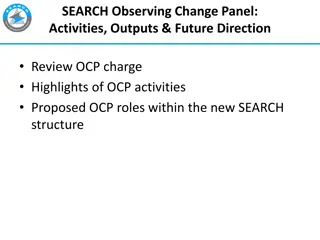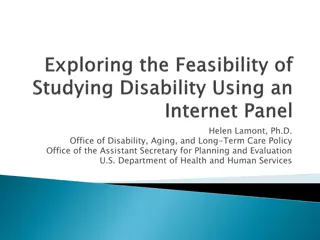
Effect of Social Security Auxiliary Benefits on Household Retirement Decision Analysis
Explore the impact of Social Security auxiliary spouse and survivor benefits on retirement decisions within households, analyzing the influence on work behavior and retirement income adequacy. Considerations include efficiency incentives, equity implications, and the historical origins of spousal benefits in the Social Security system.
Uploaded on | 0 Views
Download Presentation

Please find below an Image/Link to download the presentation.
The content on the website is provided AS IS for your information and personal use only. It may not be sold, licensed, or shared on other websites without obtaining consent from the author. If you encounter any issues during the download, it is possible that the publisher has removed the file from their server.
You are allowed to download the files provided on this website for personal or commercial use, subject to the condition that they are used lawfully. All files are the property of their respective owners.
The content on the website is provided AS IS for your information and personal use only. It may not be sold, licensed, or shared on other websites without obtaining consent from the author.
E N D
Presentation Transcript
Comments on The Effect of Social Security Auxiliary Spouse and Survivor s Benefits on the Household Retirement Decision by David Knapp Courtney Coile Wellesley College and NBER Retirement Research Consortium Conference August 7, 2014
Social Security and Retirement Why we care: falling LFP of older men during period of rising SS benefits suggests possibility of relationship Early literature focused on men, or women as 2nd movers But many couples retire together More recent literature has estimated joint models of men s and women s retirement decisions (Gustman and Steinmeier, 2000, 2004), also shown that own SS incentives affect own and spouse s decisions (Coile, 2004)
Contributions of This Paper Where this paper fits in: updated model, used to simulate cuts to spousal/survivor benefits. Why spousal benefits might affect work: Lower earner (wife): discourages work by increasing retirement income (income effect) and by reducing return to work (substitution effect) Higher earner (husband): same income effect, opposite substitution effect Findings: Women: increase work if eliminate benefits, small effect for spouse benefits (0.08 years or 2%), larger for survivors (1.27 years or 32%) Men: decrease in work if eliminate spouse benefits (0.11 years), larger for survivors (.53 years or 7%) Couples value joint life annuity provided by Social Security.
Issues Raised by Spousal Benefits Efficiency Work (dis)incentives: may affect retirement and hours worked May create DWL by breaking link between taxes & benefits Equity Spousal benefits create redistribution from singles to couples & from two-earner families to single-earner families Unfair to women? Retirement income adequacy Spouse benefit of 50% of PIA probably designed based on higher consumption needs of couple vs. single; survivor s benefit is to ensure income after worker s death. Important given imperfect private annuity markets. Even with survivor s benefits, poverty of elderly widow(er)s much greater than of elderly married couples.
The Origin of Spousal Benefits Dependent spouse and survivor benefits added to Social Security via the 1939 Amendments Text from Roosevelt s signing ceremony: These amendments to the Act represent another tremendous step forward in providing greater security for the people of this country. This is especially true in the case of the federal old age insurance system which has now been converted into a system of old age and survivors' insurance providing life-time family security instead of only individual old age security to the workers in insured occupations. In addition to the worker himself, millions of widows and orphans will now be afforded some degree of protection in the event of his death whether before or after his retirement. Other developed countries seem to be less likely to have spousal benefits than survivor benefits.
Source: SSA Annual Statistical Supplement, 2013, Table 5.A4.
Source: SSA Annual Statistical Supplement, 2013, Table 5.A4.
Source of SS Benefit Entitlement For Women 62+, 1960-2010 100% 90% 80% 70% 60% 50% 40% 30% 20% 10% 0% 1960 1965 1970 1975 1980 1985 1990 1995 2000 2005 2010 Worker Only Dually Entitled Spouse Only Source: SSA Annual Statistical Supplement 2013, Table 5.A14.
Share? of? Dually-Entitled? Recipients? of? Dependent? Spouse? Benefits? Receiving? $100? or? More? from? Spouse? Benefit Percentage? distribution? by? dollar? amount? of? retired-worker? benefit Total? combined? monthly? benefit? (dollars) Lose? $100? or? more? (conser- vative) Lose? $100? or? more? (aggres- sive) Number 200- 250 250- 300 300- 350 350- 400 400- 450 450- 500 500- 550 550- 600 600- 650 650- 700 Total <200 700+ Dually? entitled? wives? and? husbands a3,011,187 6,139 6,639 13,950 21,889 29,793 40,424 56,167 82,137 131,645 213,100 336,962 2,072,342 All <200 200-250 250-300 300-350 350-400 400-450 450-500 500-550 550-600 600-650 650-700 700+ 100 100 100 100 100 100 100 100 100 100 100 100 100 5.1 99.7 67.2 44.1 31.3 22.9 17.6 14.2 11.1 8.6 5 5.8 6.1 6.2 6.1 6.8 9.1 11.3 10.2 8.5 19.8 0.3 .? .? . 32.6 33.1 24.9 19.5 16 13.2 10.8 8.9 7.5 5.4 3 .? .? . .? .? . .? .? . .? .? . .? .? . .? .? . .? .? . .? .? . .? .? . .? .? . .? .? . .? .? . .? .? . .? .? . .? .? . .? .? . .? .? . .? .? . .? .? . .? .? . .? .? . .? .? . .? .? . .? .? . .? .? . .? .? . .? .? . .? .? . .? .? . .? .? . .? .? . .? .? . .? .? . .? .? . .? .? . .? .? . .? .? . .? .? . .? .? . .? .? . .? .? . .? .? . .? .? . .? .? . .? .? . .? .? . .? .? . .? .? . .? .? . .? .? . 0.2 .? .? . 22.7 27.4 22.3 18.6 15.7 12.7 10.2 8.4 6.4 3.9 -- -- 0.1 .? .? . 16.4 22.3 19.5 16.3 13.2 10.4 8.6 6.9 4.4 0.1 .? .? . 13 18.3 16.4 13.5 10.3 8.6 7.2 4.8 31 42 52 59 61 59 59 62 56 62 68 73 72 68 67 67 0.1 .? .? . 10 .? .? . 15.2 13.3 10.4 8.6 7.5 5 9.1 .? .? . 14.8 12.6 10.7 9.5 5.5 10.6 .? .? . 16.9 14.7 14 8 11.7 .? .? . 17.1 16 11.3 7 8.7 .? .? . 14.9 11.4 4.9 2.7 7.1 .? .? . 11.2 28.7 Color Value? of? Spouse? Benefit $1-$50 $1-$100 $50-$150 $100? or? more 59 68 Source: SSA Annual Statistical Supplement, 2013, Table 5.G5 + author s calculations
Time to Rethink Spousal Benefits? Survivor s benefits? Probably too central to retirement income adequacy of widow(er)s. Dependent spouse benefits? Less clear how central they are to poverty avoidance. Another option: splitting contributions Increases incentives to work for both spouses Gustman & Steinmeier (2004) predict would increase LFP modestly, by about 2% points. This paper shines a light on an aspect of SS benefits that probably merits greater attention.






















